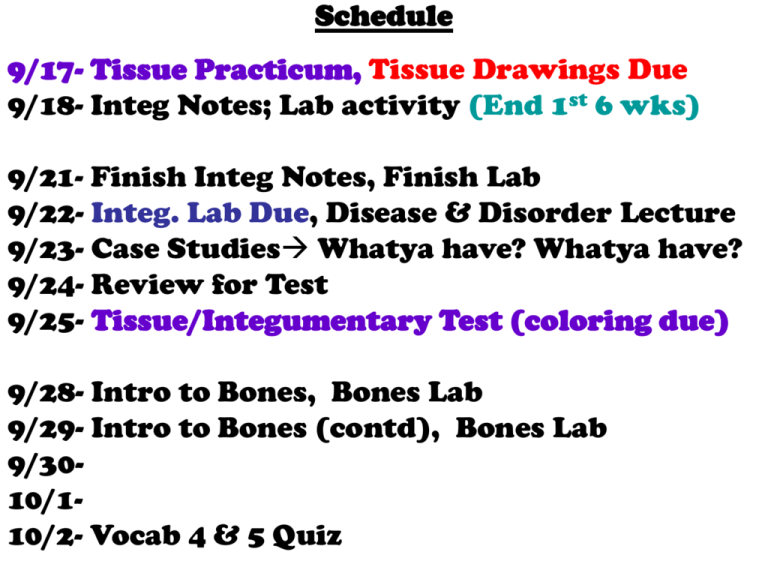Integumentary System - Brookwood High School
advertisement

Schedule 9/17- Tissue Practicum, Tissue Drawings Due 9/18- Integ Notes; Lab activity (End 1st 6 wks) 9/21- Finish Integ Notes, Finish Lab 9/22- Integ. Lab Due, Disease & Disorder Lecture 9/23- Case Studies Whatya have? Whatya have? 9/24- Review for Test 9/25- Tissue/Integumentary Test (coloring due) 9/28- Intro to Bones, Bones Lab 9/29- Intro to Bones (contd), Bones Lab 9/3010/110/2- Vocab 4 & 5 Quiz Integumentary System Chapter 5 in your textbook The Skin •Waterproof, stretchable, washable, repairs small rips, cuts and burns •The skin and the associated organs of sweat and oil glands, hairs, and nails make up the Integumentary system Fun Facts • Consists of Skin, Hair, Nails, and Glands • Avg. makes up about 9-11 lbs. or 7% of your weight • Regenerates every 25-45 days Structure • Epidermis: Stratified squamous epithelium that is keratinized • Dermis: Dense fibrous connective tissue • A burn or friction causes a separation of the layers : blister • Hypodermis or superficial facia: subcutaneous tissue; adipose tissue: anchors skin to underlying organs. Shock absorber, insulator Skin Anatomy AKA Cutaneous Membrane consists of: epidermis (epithelial) dermis (fibrous) subcutaneous layer (fat) hypodermis Epidermis • (keratinocytes & melanocytes); avascular; “tissue layer above skin”; stratified squamous epithelium; BARRIER LAYER Five layers: • Stratum corneum: “horny” layer; dead stratified squamous; look rough; keratin present (water-repellent protein); can become thick from irritation (callus) • Stratum lucidum: “clear” layer; dead cells • Stratum granulosum: “granular” layer; thin; cells dying; begin keratinization (cells move up) • Stratum spinosum: “spiny” layer; protein synthesis with RNA to generate keratin; living cells • Stratum basale: “base” layer; AKA stratum germinativum; rapid mitosis; youngest cells; melanin (pigment protects from UV light); NOTE: • Thick skin- covers palms, fingertips, soles of feet • Thin skin – covers rest of body – missing stratum lucidum and sometimes stratum granulosum Cells of the Epidermis • Keratinocytes, melanocytes, Merkel cells and Langerhan’s cells • Majority of the cells are keratinocytes – Produce keratin, a fibrous protein: protective – Connected by desmosomes and arise in the stratum basale layer until they rich the outer surface where the dominate the cells content. Here they are dead, scale-like structures – We shed our skin every 25-45 days Epidermis • Stratum basale:deepest layer; contains the only epidermal layer that receive adequate nourishment via diffusion from the dermis • Cells constantly undergoing mitosis: stratum germinativum Dermis: True Skin Contains sensory receptors for pain, pressure, touch, and temperature; vascular; forms basement membrane • • Papillary Layer- thin; projections of collagen and elastin into basement membrane; areolar tissue; elastic fibers ex. fingerprints Reticular Layer- “skin network”; thick; dense fibrous connective tissue; elastic fibers (stretchable); arrector pili muscles (attach to hair follicle & contract when cold); stretch marks (tears of elastic fibers) Papillary Layer Thin superficial areolar connective tissue with collagen and elastin fibers Superior surface appears as peg like projections called dermal papillae that indent the epidermis House Meissner’s corpuscles (touch receptors); pain receptors and capillary loops Reticular Layer 80 % of the dermal thickness is dense irregular tissue Contains blood vessels, sweat and oil glands Deep pressure receptors (Pacinian corpuscles) Phagocytes: prevent bacteria from penetrating to deeper body layers II. SKIN COLOR • GENETICS is the key factor • Quantity of melanin – (yellow to reddish- brown to black) – protects skin from UV radiation • In melanocytes, use enzyme tyrosinase to convert tyrosine into dark brown melanin pigment, albinos lack DNA code to make tyrosinase • sunlight increases melanin production by affecting release of hormones • freckles or moles are accumulations of melanin • other pigments such as carotene or hemoglobin contribute to skin color Three pigments : 1.The amount and kind of melanin (yellow, reddish brown or black) 2.The amount of carotene deposited in the stratum corneum and subcutaneous tissue 3. The amount of oxygen bound to hemoglobin SKIN Color Freckles and pigmented moles are large accumulations of melanin Melanoctyes are stimulated when the skin is exposed to sunlight Prolonged exposure causes substantial melanin buildup which helps protect the DNA of viable skin cells from UV radiation by absorbing the light and dissipating the energy as heat SKIN Color Hair: aka pili covers all of humans EXCEPT palms of hands, soles of feet, lips, nipples some genitalia 1. Hair follicle- shaft, root, medulla (inner), cortex (outer), cuticle (cover) 2. Growth- 4 in./year or 2 mm/week; male-pattern baldness- genetic, sexinfluenced, hormones (testosterone) Nails • Consists of: – – – – – – free edge Body Root Cuticle Lunula keratin • growth- 0.5 mm/week • fingernails faster than toe nails – blood flow? Skin Glands 1. Sweat Glands- AKA sudoriferous; found in palms, feet, forehead (perspiration/ sweat – 99% water) or found in axillary and anogenital regions – milky color 2. Sebaceous Glands- in dermis; secrete sebum oil for hair and skin; 2/hair; antifungal; antibacterial 3. Ceruminous Glands- cerumen or earwax; can block ear from insects Sebaceous (Oil) Glands • Found all over except on the soles and palms • Holocrine glands; ducts usually empty into a hair follicle • Sebum: mixture of oily substances and fragmented cells; acts as a lubricant that keeps skin soft and prevents the hair from becoming brittle; contains chemicals that kill bacteria Sweat (Sudoriferous) Glands • Two types: eccrine and apocrine 1. Eccrine/merocrine glands: sweat: clear secretion primarily water, salts 2. Apocrine: axillary and genital areas; Secretion contains fatty acids and proteins, as well as the eccrine substances; can appear milky-white or yellow Skin Physiology A. Protection: from microorganisms, chemicals, physical injury, dehydration, UV light B. Sensation: receptors C. Excretion: sweat contains uric acid, ammonia, urea, salt, water D. Metabolism: Vitamin D production by absorbing UV light E. Immunity: T cells, Langerhans cells, and macrophages found in the skin to fight microorganisms F. Temperature Regulation: varies from 37.6oC to 36.2oC; heat produced comes from metabolism in muscles and glands; heat is lost if blood vessels widen (vasodilation); heat is saved if blood vessels constrict (vasoconstriction); regulated by hypothalamus









